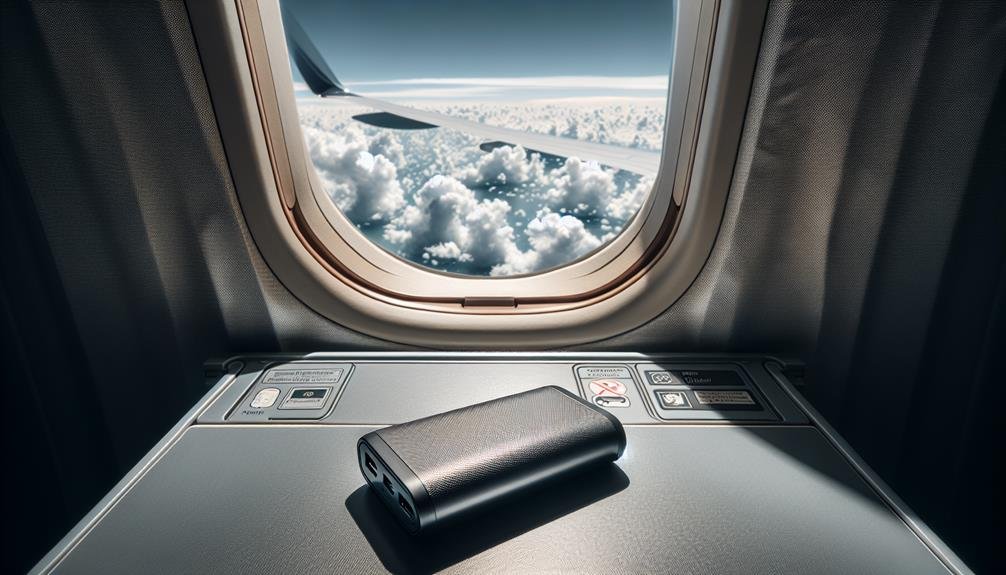Yes, you can bring power banks on flights, but they must follow specific rules. The FAA limits power banks to 100 watt-hours (Wh) per battery, and anything over 160 Wh is prohibited. Most airlines require these devices in carry-on luggage due to better incident handling and temperature regulation. For units between 100 and 160 Wh, you'll need airline approval. Always store power banks securely, avoid using them during takeoff and landing, and make sure you comply with labeling and documentation requirements. Adhering to these guidelines reduces risks and guarantees safe travel. You'll discover more essential insights below.
TSA and FAA Regulations
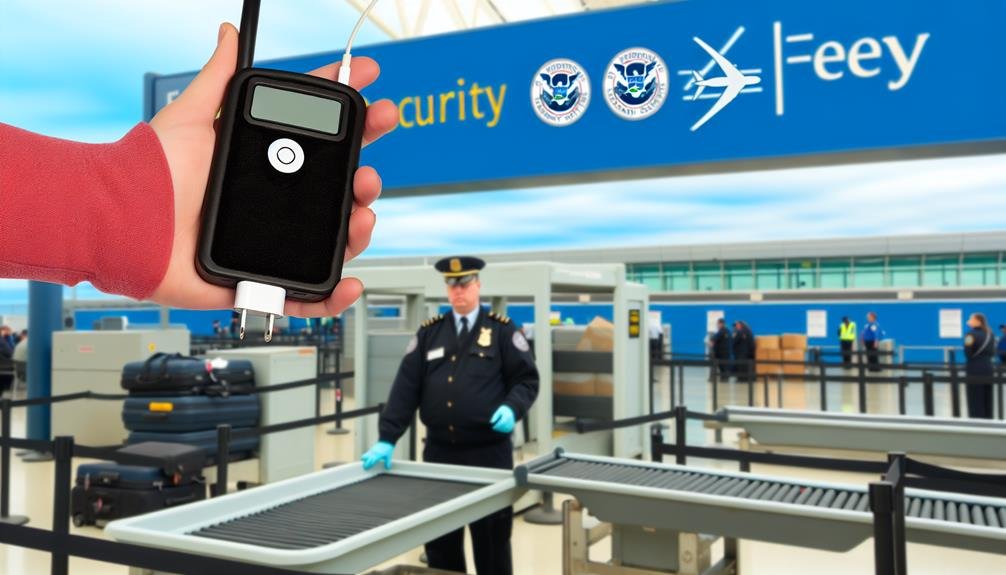
When traveling with power banks, it's important to understand the TSA and FAA regulations to guarantee compliance and avoid potential hazards. Both agencies have established guidelines to assure the safe transport of these devices, focusing on airline restrictions and airport security measures.
First, be aware of the power bank size and battery types. The FAA mandates that power banks containing lithium-ion batteries must not exceed 100 watt-hours (Wh) per battery. If your device exceeds this limit but is under 160 Wh, you can bring it on board, but you'll need prior airline approval. Batteries larger than 160 Wh are strictly prohibited in both checked and carry-on baggage to mitigate fire risks.
Airport security protocols require that all power banks be carried in your carry-on baggage. This is because lithium-ion batteries pose a higher risk when stored in the aircraft's cargo hold. When passing through airport security, be prepared to remove your power bank from your baggage for separate screening, similar to how laptops are handled.
International Airline Policies
Understanding international airline policies for power banks requires grasping the specific regulations of each carrier and country, as these can vary widely and impact your travel plans. When engaging in international travel, you'll encounter diverse airline restrictions regarding the types and sizes of power banks that are permissible on board. Most airlines mandate that power banks must be carried in your hand luggage, not in checked baggage, due to the potential risk of fire.
Compliance with airport security also plays a vital role. Different countries have varying thresholds for acceptable power bank sizes. For instance, while one airline might allow up to 100Wh without prior approval, another might cap it at 160Wh but require explicit consent from the airline for anything above that. These discrepancies necessitate thorough pre-travel research to avoid confiscation or fines.
Risk assessment is essential for ensuring the safety of all passengers. Power banks with lithium-ion batteries pose a fire hazard, which is why they're subject to strict regulation. Always check with your airline and the relevant airport security guidelines for updated rules. Safeguarding your journey starts with understanding and adhering to these international airline policies.
Power Bank Capacity Limits
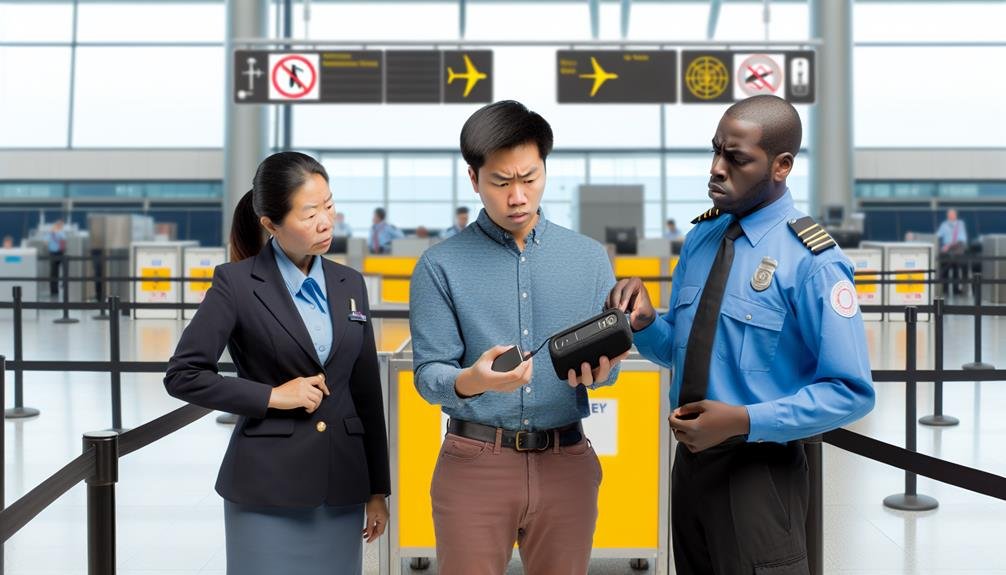
Managing power bank capacity limits is an important aspect of complying with international airline policies and guaranteeing a safe flight. Airlines generally impose power bank restrictions to mitigate risks associated with lithium-ion batteries, which can overheat or even catch fire under certain conditions. Adherence to these regulations is essential for your safety as well as that of your fellow passengers.
Most airlines allow power banks with a capacity of up to 100 watt-hours (Wh) without requiring special approval. For those between 100Wh and 160Wh, you'll usually need the airline's permission to carry them. Power banks exceeding 160Wh are typically prohibited. To calculate the watt-hours of your power bank, multiply its voltage (V) by the ampere-hours (Ah). For instance, a 5V power bank with 20,000mAh (or 20Ah) capacity equates to 100Wh.
Always check the specific power bank restrictions of the airline you're flying with, as these can vary. It's also wise to confirm your power bank has clear labeling of its capacity limits, as this simplifies the verification process during security checks. Adhering to these guidelines helps in maintaining a secure flight environment.
Carry-On Vs. Checked Luggage
In line with airline regulations, power banks should be carried in your carry-on baggage instead of checked luggage to reduce the risks associated with lithium-ion batteries. This directive mainly arises from the potential dangers these batteries pose when stored in an aircraft's cargo hold. Checked baggage risks include the chance of batteries overheating and igniting without immediate detection, putting everyone on board in danger.
Transporting power banks in carry-on baggage offers significant safety advantages. To start with, the cabin crew can promptly handle any overheating or battery malfunction incidents. Additionally, the controlled environment of the passenger cabin ensures better temperature regulation, reducing the chances of thermal runaway—a common issue with lithium-ion batteries.
From a risk assessment perspective, carry-on convenience also plays an important role. Keeping your power bank accessible means you can monitor its condition during the flight. It's easier to check if it's getting excessively warm or showing signs of swelling, allowing for immediate action if necessary. Furthermore, most airlines have specific guidelines that prohibit the inclusion of power banks in checked luggage, highlighting the importance of following these regulations for the safety of all passengers.
Safety Precautions
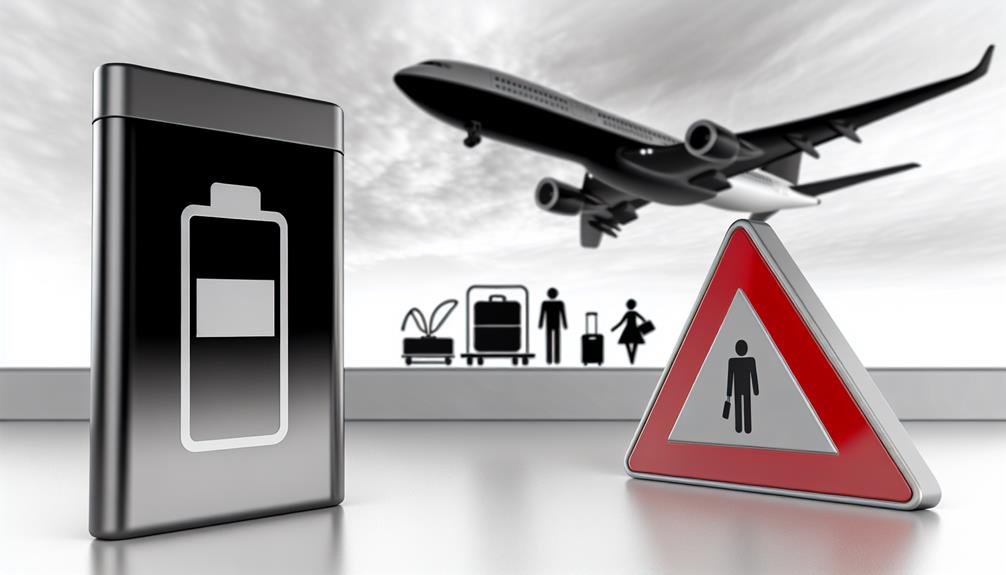
When flying with power banks, it's important to follow safety precautions to lessen risks associated with lithium-ion batteries. Guaranteeing safe power bank storage and in-flight usage can prevent potential hazards. Here are some critical guidelines you should follow:
- Proper Storage: Always keep power banks in your carry-on luggage, not in checked baggage. This allows cabin crew to address any malfunctions promptly.
- Capacity Check: Verify that your power bank doesn't exceed airline-specific capacity limits, typically around 100Wh to 160Wh. Airlines may require approval for higher capacities.
- In-Flight Usage: Avoid using power banks during takeoff and landing. Only use them when the aircraft is cruising and make sure the device remains accessible.
Following these guidelines helps in maintaining compliance with aviation safety regulations and reduces the risk of battery-related incidents. Always keep your power bank stored securely in a protective case to prevent accidental activation or damage.
Lithium-Ion Battery Concerns
When you're bringing power banks on flights, it's important to be aware of the lithium-ion battery capacity limits set by aviation authorities. These batteries pose fire hazard risks, especially if they exceed the allowable watt-hour ratings. Ensuring compliance with these regulations mitigates potential safety issues during air travel.
Battery Capacity Limits
Airlines typically enforce strict limits on lithium-ion battery capacity for power banks to mitigate potential fire hazards during flights. These charging restrictions guarantee that the batteries you carry don't exceed safe operational thresholds. Airline rules usually dictate a maximum battery size of 100 watt-hours (Wh) for carry-on power banks, with some airlines allowing up to two larger batteries between 100Wh and 160Wh, but only with prior approval. Understanding these travel restrictions is vital to avoid confiscation or fines.
When planning your trip, be aware of the following:
- Battery Capacity Limits: Confirm your power bank's capacity is clearly labeled in watt-hours or milliampere-hours (mAh). Convert mAh to Wh if needed (Wh = mAh/1000 x Voltage).
- Approval for Larger Batteries: If your power bank is between 100Wh and 160Wh, contact the airline in advance to get the necessary approval.
- Carry-On Regulations: Power banks are typically prohibited in checked luggage due to fire risks, so always carry them in your hand luggage.
Adhering to these guidelines not only ensures compliance with regulatory standards but also enhances the safety of all passengers onboard. Always check specific airline policies before you travel to stay informed and prepared.
Fire Hazard Risks
Understanding battery capacity limits is essential because lithium-ion batteries in power banks pose substantial fire hazards, especially during air travel. Lithium-ion batteries are known for their energy density, which makes them highly efficient but also prone to overheating and potentially causing fires. That's why following airline rules and regulations is vital for ensuring fire safety.
Airplane rules typically mandate that power banks must be carried in carry-on luggage rather than checked baggage. This regulation allows the cabin crew to promptly address any overheating incidents, reducing the risk of a fire spreading uncontrollably. When selecting a power bank for travel, make sure it complies with the airline's capacity limits, usually capped at 100 watt-hours (Wh) without prior approval, and up to 160 Wh with airline permission.
Risk assessment doesn't stop at compliance; it's also about choosing quality products. Opt for power banks with built-in safety features such as short-circuit protection, overcharge protection, and temperature control. These features can significantly reduce the risk of fire hazards.
Best Practices for Travel
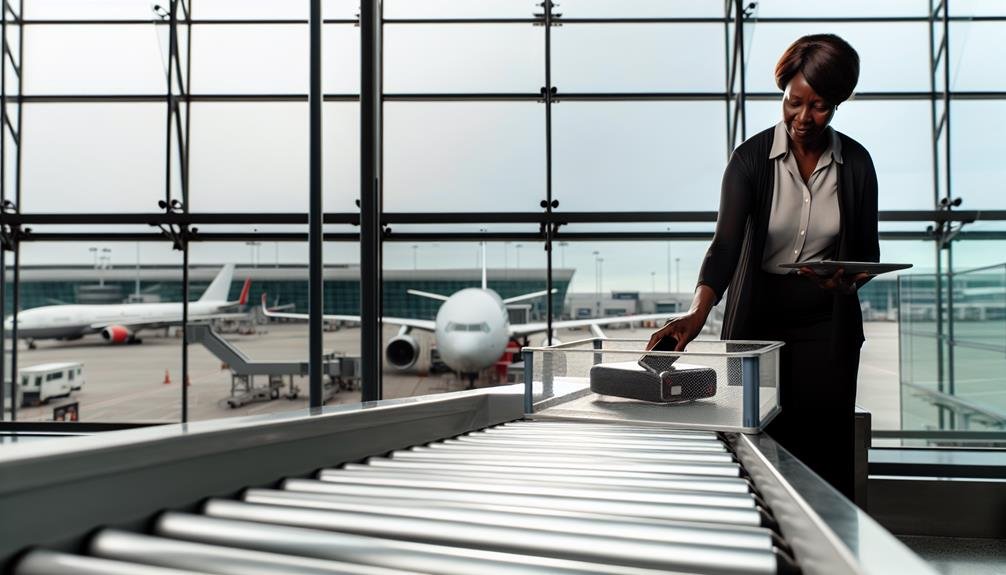
To guarantee compliance with airline regulations and to mitigate risks, always carry your power bank in your carry-on luggage rather than in checked baggage. Including a power bank in your travel essentials makes certain you're prepared for any battery-draining scenarios during your journey. To streamline your packing list, make certain to place your power bank in an easily accessible part of your carry-on. This will facilitate quick retrieval when you go through airport security, ensuring you adhere to both customs regulations and safety protocols.
For utmost safety and compliance, consider the following best practices:
- Check Capacity Limits: Verify the watt-hour (Wh) rating of your power bank. Most airlines allow up to 100Wh without special approval.
- Opt for Quality: Purchase power banks that meet recognized safety standards and certifications. Look for marks like CE, FCC, or RoHS.
- Secure Connections: Confirm all ports and cables are secure and in good condition to prevent short circuits or accidental discharges.
Adhering to these guidelines not only keeps you within regulatory compliance but also minimizes the risk of fire hazards and other safety concerns. Always stay informed about the latest airline policies to guarantee a seamless travel experience.
What to Avoid
While preparing for your flight, avoid carrying power banks with damaged batteries or unknown specifications, as they pose significant safety and compliance risks. Damaged batteries can overheat or even explode, creating hazardous situations. Power banks without clear specifications might not meet airline restrictions, leading to confiscations or fines.
Different airlines have varying rules for power bank sizes and capacities. Generally, power banks cannot exceed 100 Watt-hours (Wh) without explicit airline approval. Larger capacities may not be permitted at all. It's crucial to verify the restrictions of your specific airline to guarantee compliance and safety.
| Airline | Power Bank Size Limit | Special Conditions |
|---|---|---|
| Airline A | Up to 100 Wh | Approval needed for 100-160 Wh |
| Airline B | Up to 160 Wh | Limited to two devices per passenger |
| Airline C | Up to 100 Wh | No approval for over 100 Wh |
| Airline D | Up to 150 Wh | Must be packed in carry-on luggage |
| Airline E | Up to 100 Wh | Additional restrictions on spare units |
Verify your power bank complies with these guidelines to prevent disruptions. Always pack it in your carry-on bag, as checked luggage is not allowed for such devices. Prioritize safety by adhering to these regulations, ensuring a smooth and secure travel experience.
Tips for Smooth Security Checks
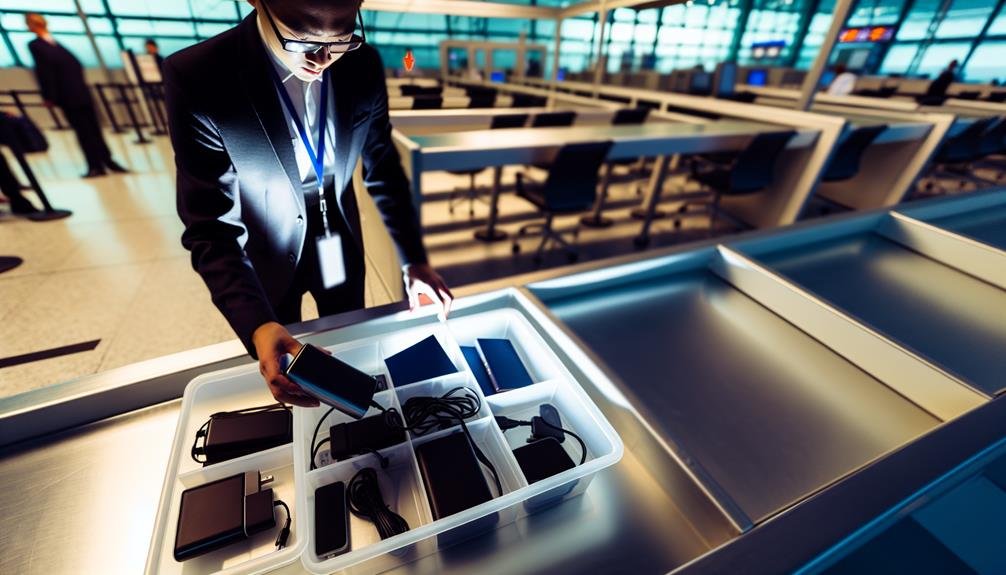
To guarantee a smooth security check, start by verifying your power bank's battery capacity to comply with airline regulations. Always pack your power bank in your carry-on luggage, as checked baggage is not permitted for such items. Finally, declare your power bank at the security checkpoint to avoid any delays.
Know Battery Capacity
Understanding the capacity of your power bank is crucial for securing compliance with airline regulations and avoiding potential delays during security checks. Airlines often have specific rules on the maximum allowable capacity for power banks, typically measured in watt-hours (Wh). Knowing this assists you in adhering to battery safety standards and maintaining proper charging etiquette.
Most airlines permit power banks with a capacity of up to 100 Wh without prior approval. For those between 100 Wh and 160 Wh, you usually require airline consent. Power banks exceeding 160 Wh are generally prohibited. To calculate the watt-hour rating, multiply the battery's voltage (V) by its ampere-hour (Ah) rating.
Key points to remember:
- Label Visibility: Ensure the capacity is clearly indicated on the power bank. Security personnel need to see this for a smooth screening process.
- Documentation: Keep documentation or manufacturer specifications handy, especially if your power bank's capacity is near the limit.
- Check Airline Policies: Regulations can vary between airlines, so verify specific requirements before traveling.
Maintaining awareness of these guidelines minimizes risks and guarantees a secure and efficient travel experience. Not only does this promote safety, but it also demonstrates responsible charging etiquette and respect for regulatory compliance.
Pack in Carry-On
Ensuring your power bank is packed in your carry-on is vital for adhering to airline regulations and facilitating a smoother security check process. Airlines require that power banks are carried in hand luggage due to the potential fire risk associated with lithium-ion batteries. By packing your power bank in your carry-on, you help mitigate this risk and comply with safety protocols.
When selecting power bank brands, opt for those with clear labeling of battery capacity and charging capabilities. This information is essential for security personnel to verify that your power bank adheres to the airline's watt-hour limits, typically not exceeding 100Wh. Some airlines may allow power banks between 100Wh and 160Wh with prior approval.
Keep your power bank easily accessible in your carry-on to expedite the security screening. Avoid burying it under other items, as this can lead to delays and additional scrutiny. Understanding the charging capabilities of your power bank can also prevent misunderstandings during inspection; make sure it's not excessively powerful for airline standards.
Declare at Security
When you reach the security checkpoint, declare your power bank to the security personnel to guarantee compliance with airline regulations and avoid potential delays. By doing so, you help safeguard the safety of all passengers and streamline the security screening process. Power banks are considered electronic devices with batteries that can pose risks if not properly handled.
During security screening, adhering to these tips can help:
- Keep it Accessible: Place your power bank in an easily reachable section of your carry-on. This allows for quick and easy inspection.
- Check Capacity: Verify that your power bank's capacity is within the airline's allowed limits, typically under 100Wh. If it's between 100Wh and 160Wh, make sure you have airline approval.
- Clear Labels: Ensure your power bank has distinct labeling of its capacity. This helps security personnel quickly verify compliance with airline regulations.
Being upfront about your electronic devices, especially power banks, minimizes the risk of confiscation or delays. Remember, regulations are in place for your safety and the safety of everyone on board. Following these guidelines guarantees a smoother, stress-free journey through security.
Frequently Asked Questions
Can I Charge My Devices With a Power Bank During the Flight?
Charging your devices mid-air can be a lifesaver! However, follow charging etiquette: guarantee your power bank's battery life meets airline regulations and avoid overloading outlets. Always prioritize safety and adhere to flight crew instructions.
Are There Brand-Specific Restrictions for Power Banks on Flights?
Yes, some airlines have brand-specific restrictions for power bank sizes. Always check airline policies, as non-compliant power banks might be confiscated for safety. Following these regulations guarantees compliance and reduces potential risks during your flight.
Do All Airlines Have the Same Rules for Transporting Power Banks?
You'll find airline differences in regulations concerning power banks. For international travel, restrictions vary widely. Always check each airline's specific rules to guarantee compliance and minimize risks, safeguarding your safety and that of other passengers.
What Should I Do if My Power Bank Malfunctions Mid-Flight?
Imagine your power bank as a rogue wave in a calm sea. If it malfunctions mid-flight, follow emergency protocols immediately. Notify the crew and use alternative power sources. Safety and regulatory compliance are paramount.
Are There Any Special Requirements for Traveling With Solar Power Banks?
When traveling with solar power banks, confirm compatibility with airline regulations. Most airlines require them in carry-on baggage, with capacity limits. Check specific airline rules to avoid risks and guarantee safe, compliant travel.

